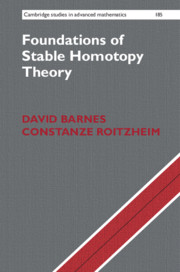Book contents
- Frontmatter
- Contents
- Introduction
- 1 Basics of Stable Homotopy Theory
- 2 Sequential Spectra and the Stable Homotopy Category
- 3 The Suspension and Loop Functors
- 4 Triangulated Categories
- 5 Modern Categories of Spectra
- 6 Monoidal Structures
- 7 Left Bousfield Localisation
- Appendix Model Categories
- References
- Index
Introduction
Published online by Cambridge University Press: 09 March 2020
- Frontmatter
- Contents
- Introduction
- 1 Basics of Stable Homotopy Theory
- 2 Sequential Spectra and the Stable Homotopy Category
- 3 The Suspension and Loop Functors
- 4 Triangulated Categories
- 5 Modern Categories of Spectra
- 6 Monoidal Structures
- 7 Left Bousfield Localisation
- Appendix Model Categories
- References
- Index
Summary
In the crudest sense, stable homotopy theory is the study of those homotopy invariant constructions of spaces which are preserved by suspension. In this chapter, we show how there are naturally occurring situations which exhibit stable behaviour. We will discuss several historic attempts at constructing a “stable homotopy category” where this stable behaviour can be studied, and we relate these to the more developed notions of spectra and the Bousfield–Friedlander model structure. Of course, if one only wants to perform calculations of stable homotopy groups, to have certain spectral sequences or similar, then one does not need much of the formalism of model categories of spectra. But as soon as one wishes to move away from those tasks and consider other stable homotopy theories (such as G–equivariant stable homotopy theory for some group G) or to make serious use of a symmetric monoidal smash product in the context of “Brave New Algebra”, then the advantages of the more formal setup become overwhelming.
- Type
- Chapter
- Information
- Foundations of Stable Homotopy Theory , pp. 1 - 6Publisher: Cambridge University PressPrint publication year: 2020

